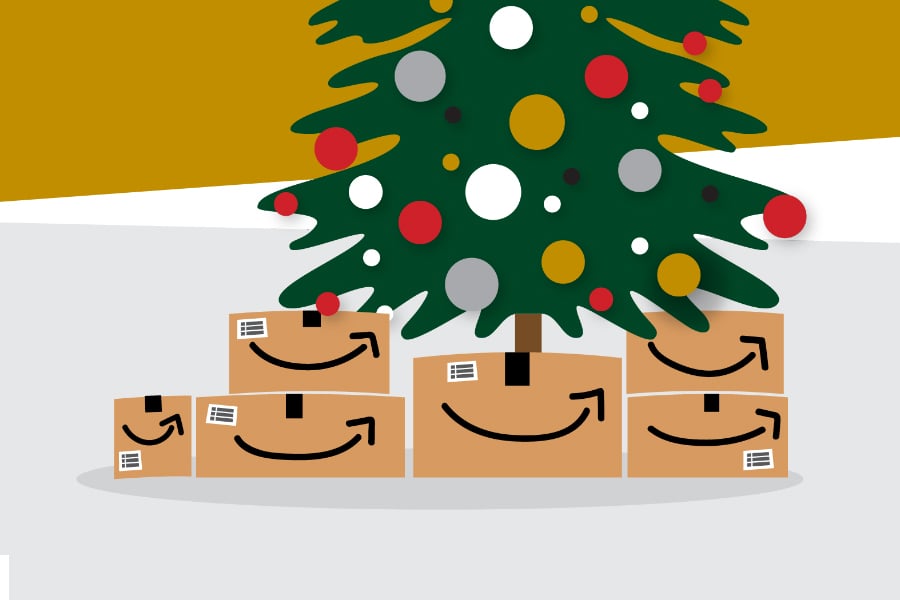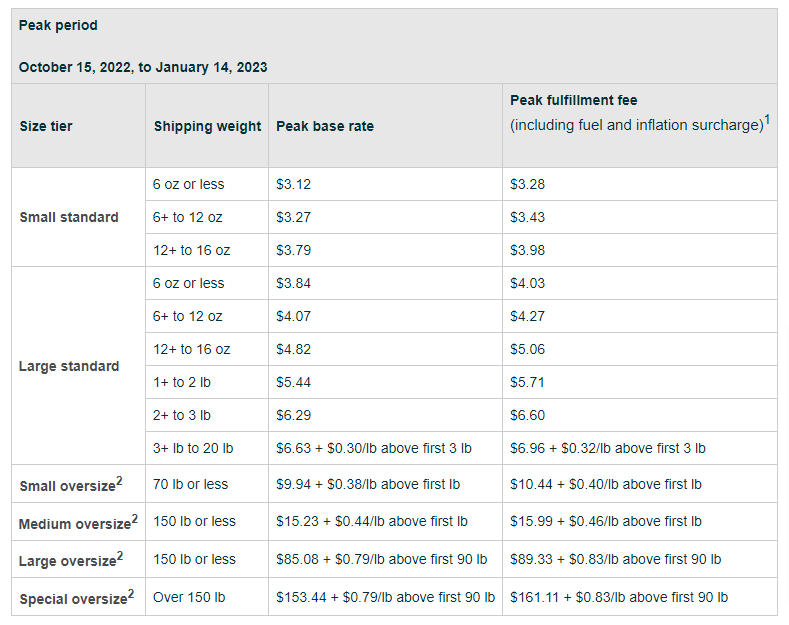Logistics
Warehousing & Fulfillment
Transportation
E-commerce
E-commerce Fulfillment Services
Lease & Maintenance
Semi Trucks
Supply Chain Technology
Logistics
E-commerce
Lease & Maintenance
Buy Used Trucks

When the holiday season begins, consumers begin flocking en-masse to one of the biggest marketplaces in the world: Amazon.
Selling on Amazon can be a great way to expand your audience during the holidays and get more exposure. It's also a massive boon for your e-commerce fulfillment strategy - if you know how to manage Amazon FBA effectively.
In this blog, we're going explore what's involved with using Amazon FBA as a fulfillment method during the holiday season - and what you need to consider to avoid the sting of extra fees and processing delays.
Fulfilled By Amazon, also known as FBA, is an e-commerce fulfillment service operated by Amazon where sellers on the platform can take advantage of their nationwide fulfillment and storage network. Amazon sellers simply prepare and send their inventory to Amazon fulfillment centers. When a customer places an order, Amazon is responsible for picking, packing, and shipping the order, as well as handling any potential returns or exchanges.
To use Amazon FBA, ecommerce businesses must have active Amazon listings, and the service can only be used to fulfill orders placed through the Amazon channel. To have Amazon fulfill orders placed in other sales channels, you'll have to use Amazon's companion fulfillment service, Amazon multi-channel fulfillment (MCF). To find out more about Amazon MCF and how it differs from Amazon FBA products, check out our guide.
Hybrid fulfillment, where ecommerce businesses use more than one fulfillment method, has become increasingly common as brands build market share and expand their sales channels. Amazon FBA has emerged as a straightforward option for e-commerce sellers during the holiday season who want to outsource fulfillment while maintaining control over inventory planning and shipping.
FBA is a popular fulfillment option because Amazon's massive logistics network has more resources to support customer expectations for rapid delivery timeframes, something that many brands struggle to achieve with in-house fulfillment.
Best of all, orders fulfilled using FBA are automatically eligible for Prime free shipping expedited delivery, which makes you much more appealing to customers during the holiday shopping season.
Using FBA is a great gateway into other Amazon services, such as Amazon Multi-Channel Fulfillment (MCF). By also fulfilling orders via MCF, brands get to leverage Amazon’s fulfillment network to ship orders placed on eBay, Shopify stores, and more without needing to bring in another third party.
While Amazon FBA offers e-commerce merchants a lot of perks, there are a few things that merchants will need to consider if they plan on using FBA during the holiday season. Because it’s peak selling activity during November-December, Amazon has a variety of conditions for using its services that are different from the rest of the year. If you don't do your due diligence, you can easily get caught out and end up spending unnecessary time and money on fulfillment.
There are some key dates that Amazon sellers need to remember to make sure they order inventory in time to send it over to their fulfillment center in time for the holiday season. Otherwise, you may not have enough inventory to meet peak season demand.
FBA holiday selling dates for 2022 are as follows:
Black Friday and Cyber Monday: November 2, 2022
Christmas: December 1, 2022
Note that these dates are subject to change, so keep checking Amazon seller central to know when you should start preparing your inventory.
It's commonplace for 3PLs and shipping carriers to rely on peak season surcharges to manage increased demand during the holiday rush. These temporary rate hikes are designed to cover higher operational costs, and can be applied to everything from additional handling to oversize packages and residential delivery. Most surcharges are in place during the busiest time of year, from November to mid-December, though they are increasing starting earlier and finishing later.
Amazon sellers might not be that aware of peak season surcharges, as the e-commerce giant hasn't traditionally used fees to manage increased costs during the holiday season. However, this is set to change in 2022, with Amazon FBA deciding to add a peak season fulfillment fee for its services for the holiday season. Amazon is blaming inflation for making it impossible for them to absorb these cost increases, stating that their service remains 70% less expensive than other two-day shipping alternatives for ecommerce businesses during the holiday shopping season.
Amazon FBA's peak fulfillment fees are in effect from October 15th, 2022, to January 14th, 2023, and equates to an average additional cost of $0.35 per item fulfilled using Amazon:

While this doesn't sound like a lot, this additional cost will quickly add up for top sellers who are processing huge order volumes through Amazon FBA. Many sellers will need to factor these additional fees into what they're charging customers for shipping.
As we mentioned earlier, space is at a premium in Amazon fulfillment centers during the holiday season. Amazon sellers should start preparing for the holidays by making sure that any SKUs they're paying to store at an Amazon facility are going to perform strongly.
Excess inventory is extremely costly during any time of the year, but especially during Q4. FBA sellers can be heavily penalized for excess inventory, because it causes Amazon to tie up storage space with SKUs that aren't bringing in much revenue. Amazon uses what it calls an Inventory Performance Index (IPI) to measure the efficiency of inventory management among sellers. This takes into account two things:
IPI score determines Amazon sellers' storage limitations. A score of 350-499 could mean Amazon restricting your storage capacity, which is bad news ahead of the holiday season. Moreover, costly long-term storage fees kick in once items have been stored for a year or more. This equates to $6.90 per cubic foot of storage or $0.15 per product (whichever is greater).
In sum, now is the time to start culling SKUs that are taking up space and replacing them with more successful products that can be restocked easily and achieve a high sell-through rate. This helps you achieve a good IPI score and even be awarded additional storage space for the holiday shopping season.
During the holiday season, Amazon implements what is known as restock limits, which restrict how much inventory sellers are allowed to store at fulfillment centers at one time.
The size of your restock limit will depend on your IPI score and how well your Amazon business is managing its inventory. Storage space is allocated according to how successful you are with your Amazon channel. The bigger your order volumes and the higher your inventory turnover, the higher your restock limits will be.
Restock limits are something of a catch-22 for brands. An Amazon business wants to sell products as frequently as possible during the holidays, but they may be constrained by not having enough inventory on hand to meet demand. According to some reports, sellers may face as much as a 40-60% drop in storage capacity during the holidays - right when they need it the most.
There are several ways that sellers can deal with this problem. Shipping small replenishment orders more frequently, for example, will help you to stay within restock limits. You can also partner with a 3PL provider who can store your overflow inventory until it's ready to go to Amazon.
As any seller knows, Amazon can be a cut-throat platform. In such a saturated marketplace, there's always another brand ready and willing to undercut competitors, especially during the holiday season. But with millions of product listings on-site, it's virtually impossible to keep track of how your pricing compares with other sellers - especially if you're selling hundreds of items.
Fortunately, Amazon offers a pricing automation tool that adjusts your pricing based on what your competitors are asking for. As well as keeping your brand competitive, this also increases the odds of your product becoming a Featured Offer or Buy Box. While automated pricing helps to save you valuable time managing product listings during the holidays, you need to calculate appropriate price limits to avoid making a loss on sales.
Many ecommerce businesses need to adjust their return policy during the holiday season to accommodate gift-buying behaviors. Brands experience more sales during peak season, which also means higher return rates. Lengthening return windows not only give shoppers more flexibility, but also help sellers to spread out returns over a longer period to avoid processing delays.
One of the conditions of being an Amazon seller is that you have to enforce the platform's return policy on Amazon sales - even if it may differ from what you might elect to offer. Moreover, Amazon routinely adjusts its return window during the holiday season to take into account shopper behavior.
In 2022, the shopping season started earlier than ever, thanks to consumers trying to avoid more inflation-based price hikes. According to Amazon's return guide, products purchased between October 7, 2022, and December 31, 2022, are returnable through to January 31, 2023.
Naturally, a generous holiday returns policy like this will result in more returns overall for sellers to process. Since there is no 'opt out', brands using FBA will need to make sure they have all their ducks in a row to manage returns effectively.
In addition to tough restock limits during the holidays, Amazon FBA also has extremely precise requirements for packaging and labelling on products that it stores in its fulfillment centers. This can be difficult for brands to coordinate in-house, and having inventory rejected for not meeting these requirements can be very costly during the holiday season.
Struggles with Amazon inventory management can result in unnecessary stockouts and missed sales opportunities, which could hurt the reputation of your Amazon business. This is where having a 3PL partner to manage your Amazon inventory during the holidays can be invaluable to streamline your operation and stay on top of changing requirements.
Amazon FBA can be a highly convenient e-commerce fulfillment option for sellers during the holiday season, but it's important to be aware that FBA does come with strings attached that can make managing order fulfillment challenging and expensive. By preparing early for the demands of fulfilling and selling on Amazon and outsourcing to a 3PL for some extra help, you can ensure this Amazon holiday season is a successful one.
Want to find out more about managing outsourced fulfillment during the holiday season? Check out Ryder E-commerce By Ryder's full holiday fulfillment guide for the best tips and tricks for a profitable peak season.